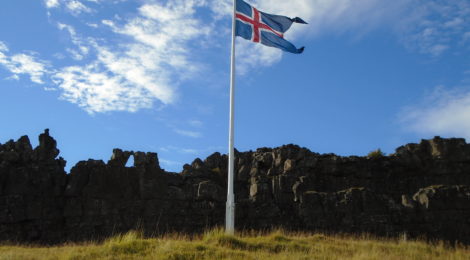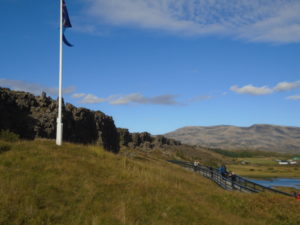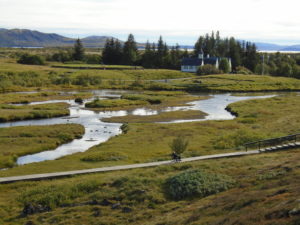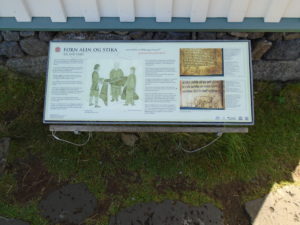
Þingvellir (Thingvellir)
Þingvellir, anglicised as Thingvellir, is the location of the Allthing or the gathering of the elected chieftains from each of the 36 districts that made up Iceland and is on the list of UNESCO World Heritage Sites. At this gathering the business of ruling the country and administering judgement for offences was carried out, but it was also a time to conduct trade and to forge alliances with other chieftains, through oaths and weddings. The location of Thingvellir made it readily accessible from every part of the country and the hill itself made a natural podium from which one’s voice could be heard far and wide in a crowd. The cliff behind is notably the fault line between the North American and Eurasian continents which is separating at a rate of 2 cm per year.

Thingvellir – Oratory Mound
The governing body at the Allthing were 3 elected judges, who would be elected for a 3 year term and had to memorise 1 third of the laws of Iceland, each judge then held absolute authority over his section of the law book and could conceivably modify it to his and his clan’s benefit. This governmental structure provided an early form of democracy and talking over issues became an Icelandic custom. Because of this, the country has never had to contend with religious war, which plagued Europe and much of the world. When confronted with Catholicism in 999 CE, the people of Iceland compromised and were all baptised at once in a single ceremony, but they would keep their pagan beliefs at home in private. This weird arrangement would lead to odd things like a Catholic bishop with allegedly 40 children resisting the Danish king’s order to convert to Lutheranism, for which he was beheaded. He was captured in the battle of Sauðafell in 1550, which was the closest to a religious war Iceland ever saw.

View from Oratory Mound
The other important function of the Allthing was to provide an occasion to trade with all the merchants from across the island. One of the most important goods in Iceland was wool cloth from the sheep farms, the primary type of farming there. Length was measured by Ell which was typically the distance from the tip of the fingers to the elbow, but this method obviously could lead to much conflict due to the variability. A standardised Ell was established at the Thingvellir church where a 2 Ell stick equal to one tenth the length of the church was kept.

The Standardised Ell Stick of Thingvellir
Iceland’s medieval history has been preserved in sagas written in old Icelandic, which incidentally hasn’t changed much and can provide us with the closest approximation as to how Old Norse may have been spoken. The sagas recount the stories of heroes and of famous events, some of the most famous include:
- Grettis saga: An account life of Grettir Ásmundarson and his forefathers. Grettir was headstrong, ill-tempered and quick to action, something he would often come to regret. His life is a continuous string of bad lucks that lead to a final heroic stand on the desolated Icelandic isle of Drangey.
- Grœnlendinga saga and Eiríks saga rauða: Are the two primary sources covering the exploits of Erik the Red, Leif Ericson and Thorfinn Karlsefni in their explorations of Greenland and Vinland, the first Europeans in North America and the establishments of settlements like L’Anse aux Meadows.
- Egil’s saga: A family’s story spanning two and a half centuries from Norway to Iceland which have influenced modern perception of the Norse and Viking cultures.
The Icelandic civil war, also referred to as the Age of the Sturlungs, was a period of internal strife lasting 42-44 years during the middle of the 13th century where a handful of clans vied for power. Named after the most powerful of these clans, the Sturlungs, this fighting lead to the dissolution of the Icelandic commonwealth and the subjugation of Iceland to the king of Norway. Iceland would remain a possession, first of the Norwegian crown and then of the Danish crown until the British preemptively invaded the island nation in the wake of Hitler’s conquest of Denmark. This event would lead to the founding of the Republic of Iceland on the 25th of February 1944. A Republican celebration was held at Thingvellir on June 17th 1944 where the Icelandic flag was raised before the assembled parliament and what was estimated as up to a third of the nation’s population.
